Put a $500 HD camcorder side-by-side with a $1,500 model, and you may be hard-pressed to tell the difference. Until you dig into the acronym soup of specs. Peek under the hood, and you'll find vast differences in quality and functionality. You just need to know what to look for. Here are some of the key features that differentiate the latest crop of HD camcorders, and why they are important.
Video Format & Resolution
Unless you are on a very limited budget, don't look at anything less than 1080p (1920x1080 progressive scan) recording, also called "Full HD," "True HD" or "Ultra HD" by vendors. Full 1080p will yield smoother and better looking results than either 1080i or 720p, the two other possible HD resolutions. Most 1080p camcorders also let you record in lower resolutions if desired, and 1080p models are now available in all price ranges, so there is little reason to go with anything less.
The other major spec to look at is the video format your movies will be recorded in. This has a major impact on how you will be able to use the video in your computer. Some formats can be used directly by various applications, or copied straight to your iPod or other portable player, and some require conversion.
The three most common are AVCHD, H.264 and HDV. AVCHD and H.264 are recorded to flash memory, memory card, hard disk or optical disc in the camcorder, while HDV is recorded to MiniDV tape.
AVCHD stands for Advanced Video Codec High Definition, and uses the MPEG-4 AVC/H.264 compression scheme. AVCHD is a newer and more efficient format than HDV, which uses the older MPEG-2 codec (also used by DVDs). Thus AVCHD files will be smaller than HDV files at any given quality level.
AVCHD and HDV are found in the highest quality camcorders, the ones that have bit rates up to the maximum possible -- 24Mbps for AVCHD and 25Mbps for HDV. Higher bit rates mean less image compression, and therefore higher quality and larger file sizes. Camcorders that can record 1080p video at maximum bit rates are generally the most expensive, and tend to have better lenses, image sensors and other features as well.
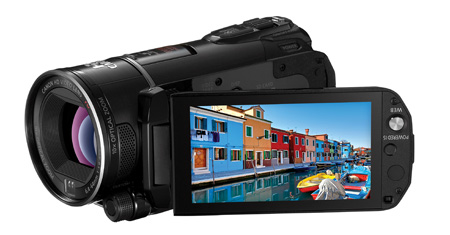
The Canon Vixia HF-S20 is a 1080p AVCHD camcorder that records up to 24Mbps video as well as 8MP still images.
Finally, most pocket HD camcorders record directly in the H.264 format, using either MPEG-4 or AVI codecs. Cameras that record in H.264/MPEG-4 can be used to upload video direct to YouTube, iPod or PSP, with no conversion required, but are typically much lower quality than the full-size AVHCD or HDV models.
So what does all this boil down to when choosing an HD camcorder? Go with an H.264 model if you primarily want to shoot video for the Web, and also want a pocketable model. For top quality, you can go with either AVCHD or HDV, but AVCHD video is easier to copy to your hard disk, since you can simply drag and drop files on the desktop. And while AVCHD used to be difficult to edit, most computer video editing programs, including Roxio VideoWave on the PC and iMovie on the Mac, now support it.
Storage Media
As mentioned above, there are several possible storage formats for video: built-in flash memory, removable memory cards, hard drives, miniDVDs, and MiniDV tape. Some built-in flash memory is nice, but the most convenient type of storage is probably removable memory cards. They add little size or weight, compared to hard drives, discs or tapes, and dramatic drops in memory card prices have also made it affordable to carry spare cards.
The latest memory card format making its way into HD camcorders is SXDC, which expands the maximum capacity to an amazing 2 terabytes, from just 32GB for SHDC. SXDC cards up to 64GB are available now. With a 64GB card, you can record up to 6 hours of top-quality 24Mbps, 1080p AVCHD video.
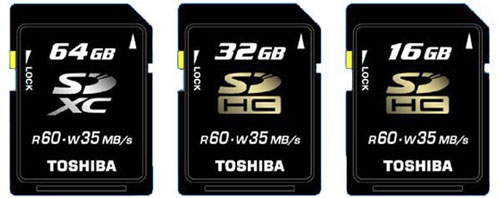
SXDC memory cards can go all the way up to 2 terabytes.
At some point, however, you will need to transfer recordings on memory cards or internal storage to permanent storage like external hard drives, DVDs or Blu-ray discs. Roxio Creator and Roxio Toast make this process easy, with convenient AVCHD archiving capabilities that let you record direct to DVD or Blu-ray disc for both playback and storage. Of course, miniDVDs and tapes serve as their own long-term storage media, and may be the best choice if you travel a lot and don't have the means to archive your video on the go.
Lenses & Zooms
In general, the better and more expensive the camcorder, the better the lens. In a given price range, look for lenses with the longest "optical" zooms, and the best low-light performance. With optical zoom, you get a full-resolution picture at the longest zoom. With digital zoom, the picture is basically a cropped and enlarged portion of the full-resolution image, and you'll lose a lot of quality. Many manufacturers specify a combination of optical and digital zoom, such as 10X optical/200X digital, but the optical number is the one to focus on.
Some camcorders have staggeringly high optical zoom numbers, such as 60X or 70X. These can be useful in some situations, such as sports and big game-viewing, where you can't get closer to your subject. However, note that you'll likely need a tripod to use them, since at these long zooms, even the slightest camera movement can look like an earthquake. Image-stabilization (see below) helps, but a tripod is better.
For low-light performance, look at the minimum illumination number given for the camcorder (7 lux or lower is good). In general, cameras with larger CCD or CMOS chips (image sensors) have better low-light performance, with less grain showing. If you do a lot of indoor shooting, however, it's probably a good idea to invest in a video light as well.
Video Outputs
HD camcorders typically have multiple types of outputs. For transferring the video to your computer, there may be USB 2.0 or FireWire (also known as IEEE 1394 or i.Link) jacks. Just be sure that if you buy a FireWire camcorder, that you also have a FireWire port on your computer. For viewing your recordings on TV, there may be HDMI or component jacks. HDMI is simpler and more convenient as long as you have an HDMI port on your TV. Then there may also be separate audio inputs and outputs, which let you attach external microphones or listen via headphones. Some cameras also offer DLNA support. With DLNA in both camera and your TV or media device, you can be sure of playing back your video without conversion.
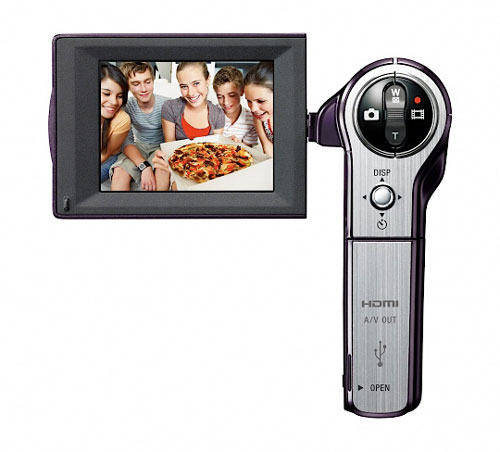
The Sony Bloggie MHS-CM5 camera has USB 2.0 and HDMI outputs, and records in H.264/MPEG-4 for direct upload to Web or portable player. It also has face detection and image stabilization.
Image Stabilization
Also called shake reduction or steady shot, image stabilization is one of the most important features to make its way into consumer camcorders in recent years. As resolution gets higher, zooms get longer, and cameras get smaller, it becomes harder and harder to avoid visible camera movement while shooting.
That's where fancy electronic stabilization comes in, that automatically adjusts for small movements in the picture. As with zoom lenses, optical image stabilization is preferable to digital stabilization, where the effect is only applied after recording and reduces overall quality slightly.
While optical stabilization is great, the poor man's solution is simply to use a tripod, or steady your camera against a tree or wall. We keep a little flexible tripod, that can wrap around a pipe or tree branch or sit on a table, in our camera bag at all times.
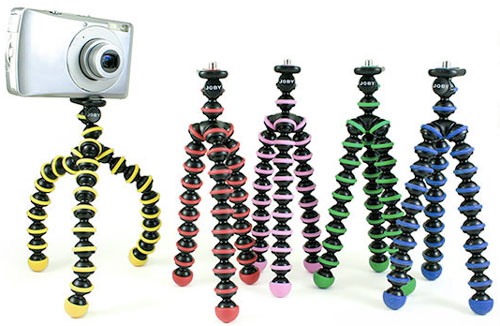
The sure-fire way to stabilize your shots is to use a tripod.
Face Tracking
Face tracking, or face detection, is another recent innovation that can greatly improve the quality of your video. By recognizing faces in the picture, the camera can adjust focus and color for sharp subjects and natural skin tones, no matter where they are in the frame. Some cameras even let you touch the face that you want to prioritize on their LCDs.
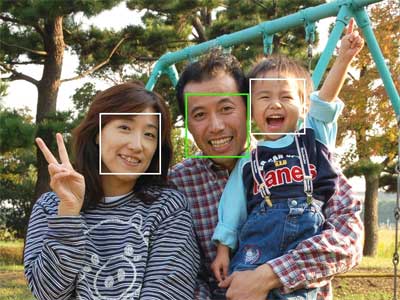
Face tracking lets you shoot off-center subjects easily.
Geotagging
With geotagging, you'll always know exactly where a video or photo was shot. Cameras with this capability have built-in GPS receivers, and "tag" your videos so you can view them on a map. This is an especially good feature for outdoor sports and travel. Imagine recording your location as you shoot while hiking the Appalachian Trail or cruising in the Caribbean.
Some cameras also allow geotagging with external GPS receivers, by connecting them via Bluetooth.
Video Panoramas
Probably the coolest new feature to show up in camcorders at the 2010 Consumer Electronics Show is 360-degree video panorama recording. Found in an inexpensive pocket cam, the 360-degree recording is achieved with a special lens attachment. It works for both photos and videos.
Still Photo Capability
Last but not least, we would be remiss if we didn't mention that today's camcorders are often also excellent still cameras. This combination lets you carry just one camera in your pocket, instead of two, although the still capability won't be as feature-filled or convenient as that of a dedicated camera. Look for at least 5-megapixel still photo support, plus the ability to switch quickly between still and video modes. You don't want to miss the shot because you were fumbling with controls or menus!